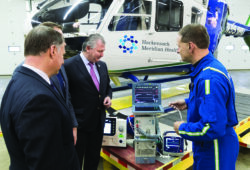LifePoint Sets Goals for Its Patient and Family Advisory Board
.
Rusty Holman, M.D., chief medical officer for LifePoint Hospitals, a Brentwood, Tennessee-based hospital operator, recently helped launch an enterprise-wide Patient and Family Advisory Board to incorporate patient and family perspectives into the organization’s strategic decisions. The 14-member board will meet in person several times a year to help LifePoint develop ways to address the challenges of healthcare reform and continue to improve patient safety and quality.
Holman talked to The Source about the group’s objective of helping LifePoint partner more closely with patients and families in driving excellence in quality and service.
What was the genesis of LifePoint’s patient-centered advisory board?
Healthcare has been either a system- or physician-centric industry for a long time, but the quest to develop more of a patient- and family-centered culture has also been an idea for a number of years. The 2001 Institute of Medicine report, “Crossing the Quality Chasm,” defined patient-centeredness as one of the primary elements of healthcare quality. Patient-centeredness is the most difficult and elusive component of quality because it means a lot of different things to different people. It also fundamentally changes systems and how goals and daily work are oriented.
LifePoint has been part of the Centers for Medicare and Medicaid Services’ (CMS) grant-funded Hospital Engagement Network (HEN) for the last three years. This network, which came out of the broader CMS program Partnership for Patients, set specific goals for partnering organizations. One goal was to reduce patient harm by 40 percent over the course of three years.
Another program goal was to much more significantly engage patients and families in their own care and in the design of care itself. It was left up to the organizations to define what that meant. Part of LifePoint’s definition included the creation of a national Patient and Family Advisory Board to influence and guide its enterprise-wide strategy for delivering high-quality care and exceptional patient service.
Did you model your board after others in the healthcare industry? How is yours different?
Similar groups can be found at some U.S. hospitals and health systems. Duke University Health System, for example, has patient advisory councils.
What we’re doing is unique, though, for a number of reasons. One is that LifePoint spans 21 states, so the scope and breadth of this advisory board is vast compared to those of individual hospitals and most health systems.
Second, instead of middle managers or those at the staff level, our board comprises LifePoint’s top-level executives, including CEO Bill Carpenter and Chief Administrative Officer John Bumpus. When it comes to delivering a talent management strategy for the company, John looks to patients and families for guidance on the skills and attributes they expect of a patient-centered workforce. Also on the board is LifePoint’s Chief Information Officer Sean Tuley, to help us navigate and evolve our technology strategy so it keeps a patient-centered focus; Vice President of Quality Dr. Karen Frush; and Central Group Chief Nursing Officer Michelle Watson, in charge of many aspects of clinical operations. It’s a very diverse but purposeful group that leads organizational direction in key areas.
Finally, my co-chair on the advisory board is a patient member. We work in complete collaboration to plan meetings, set agendas and address input from other members in developing our work plan. We felt it would be critical to demonstrate the power of partnership by having the group under joint leadership.
What is the board’s mission?
The mission statement that the board collaboratively wrote is uplifting: “Inspiring and embracing the patient and family voice to make communities healthier.” It echoes and accelerates LifePoint’s mission—“Making Communities Healthier.”
How is the board structured?
The first few meetings have been formative, as we’ve defined our mission from the ground up. We’ve focused quite a bit of time on getting to know one another because we want candor and transparency in our discussions. To do that, it’s important to build a lot of trust and rapport.
Moving forward, we’ll be defining mutual expectations. What are the advisory board’s expectations of LifePoint and vice versa? Rather than presenting the board with a fully formed idea for its rubber stamp, we’ll build ideas together to ensure a high degree of ownership.
I’ve observed this kind of group at some other organizations functions more as a focus group, where the organization brings ideas and plans to a patient council and uses it as a sounding board. At LifePoint, we’re looking at the board as an entity that works together to define the mission, vision and agenda. I work with patient co-chair Amy Buesing to plan our priorities and scope of work. The board is a strategic voice for LifePoint that goes beyond a mere focus group.
What are the board’s goals for 2015?
Our first goal is to formulate an enterprise-wide patient and family engagement plan for 2015. We would like this board to have a lot of input on the dimensions of this plan. It’s important to note that this board is meant to lend a broad, high-level strategic view rather than drive tactical measures to be implemented at any single hospital.
Our second goal is to walk the board through the results of a recent survey of all LifePoint employees and physicians regarding our culture of safety and level of employee engagement. We hope the board will help us determine next steps and where to invest in resources toward improving our culture of safety.
Finally, regarding our 2015 quality strategy across the enterprise, we’re looking at a number of opportunities to enhance patient service and quality, and we’ll be asking patients and families for their ideas.
How do you feel about discussing survey results with the board, when some comments could be less than positive about the organization?
It’s a remarkable thing when you’re discussing company results in the presence of patients and family members. It renders a completely different level of transparency. You’re fully disclosing the successes and shortcomings and asking for a true partnership in order to get better. Quite honestly, an organization can be pretty vulnerable with such transparency. That’s why we’ve spent so much time on the trust-building side of the board’s formation; we want to make sure the group knows enough about the organization as a whole to put that information in context.
At our next meeting, when we discuss the culture of safety and employee engagement, hypothetically we might have results that reveal a particular segment of our workforce doesn’t feel very engaged. Or we might have results that say our culture of safety could be improved in this particular area, or that we need to improve teamwork. As we expose a part of the organization that’s not as glamorous as other parts, I know we’ll see opportunities for improvement. This board can help us confront those opportunities together. We can come up with better solutions than we could on our own.
What else do you envision this board doing for LifePoint?
One thing about this group that will be very powerful is humanizing the important work we do in regard to quality and service. We have a tendency to talk about diseases, cases or volume instead of talking about people’s lives. This strategy certainly changes the conversation. It’ll be a terrific growth experience.
Culturally, LifePoint is highly energized and committed to quality and service. This board will serve to enhance that commitment and bring the voice of patients and families to our headquarters in Brentwood.
Share Email





